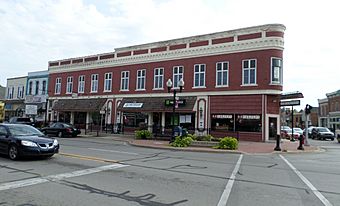Williamston Downtown Historic District facts for kids
Quick facts for kids |
|
|
Williamston Downtown Historic District
|
|
 |
|
| Location | 1st blocks of E. & W. Grand River Ave. & S. Putnam St., Williamston, Michigan |
|---|---|
| Area | 8 acres (3.2 ha) |
| Built | 1874 |
| Architect | Hiram E. Higbee, et al. |
| Architectural style | Modern Movement, Late Victorian |
| NRHP reference No. | 12001029 |
| Added to NRHP | December 12, 2012 |
The Williamston Downtown Historic District is a special area in Williamston, Michigan. It's a collection of old buildings that show how the town's main shopping area used to look. This district includes the first few blocks of East and West Grand River Avenue and South Putnam Street.
In 2012, this important area was added to the National Register of Historic Places. This means it's recognized as a place with a lot of history that is worth protecting.
Contents
History of Williamston's Downtown
Early Days and Growth
People first started settling around Williamston in the late 1830s. By the early 1840s, there was a sawmill and a gristmill, which helped the community grow. The first shop opened in 1843, and a place to stay (a tavern) opened in 1845.
In that same year, Oswald B. Williams planned out the town of Williamston. This plan covered the area west of Putnam Street. In the early 1850s, Grand River Avenue was improved. This made it easier for travelers to pass through, and a hotel opened in 1853.
The Railroad Arrives
The land east of Putnam Street was planned out in 1866. A big change happened in 1871 when the Detroit, Howell and Lansing Railroad was built through Williamston. This brought a lot of new business and people to the town.
By 1874, many shops were open near the train station. There were also many retail stores along Grand River Avenue. This area became the heart of what is now the historic district. Through the 1870s, the business area kept getting bigger. New brick buildings were added next to the older wooden ones.
Changes Over Time
Growth slowed down in the 1880s. However, the downtown area continued to change. New brick buildings often replaced the older wooden ones. This happened even faster because of several fires in the 1890s and early 1900s. These fires destroyed some of the older wooden structures.
In the 1920s, Williamston's downtown grew again. Grand River Avenue was rebuilt and paved, making it better for cars. New businesses related to cars, like garages, also appeared. The town's population grew steadily from the 1920s to the 1960s.
Modern Challenges and Adaptations
In the early 1960s, Interstate 96 was built. This highway allowed travelers to bypass the downtown area. Then, in the early 1970s, Meridian Mall was built. This gave shoppers another place to go instead of downtown.
Because of these changes, the types of businesses in the district slowly changed. In the 1980s and 1990s, antique stores and restaurants started to replace some of the older, more traditional shops.
What the District Looks Like Today
The Williamston Downtown Historic District is made up of the old commercial buildings that form the center of the town. It's mainly around where Grand River Avenue and Putnam Street meet.
Buildings and Styles
The district has 49 buildings in total. About 39 of these buildings help show the historical character of the area. Most of the buildings are shops or businesses. The only exception is the City Hall.
These buildings were built from the early 1870s to the 1950s. Many of them show popular architectural styles from those times. You can see buildings in the Italianate style, the Second Empire style, and other Late Victorian styles. Many are also in a simpler "Commercial Brick" style.
Most buildings are one or two stories tall. However, there are three buildings near the main intersection that are three stories high. Most of the buildings are made of brick, usually red brick.
Key Victorian Buildings
When you look at the district, the buildings from the Victorian era really stand out. At the four corners of Grand River and Putnam, you'll find some of the biggest and most interesting buildings. These are all from the Victorian period.
Two of the oldest buildings in the district are here. The Bowerman Block is in the Italianate style, and the National Block is in the Second Empire style. Both were built in 1874. Also at this intersection are the Andrews Hotel, built in 1887, and the Leasia Building from 1899.

